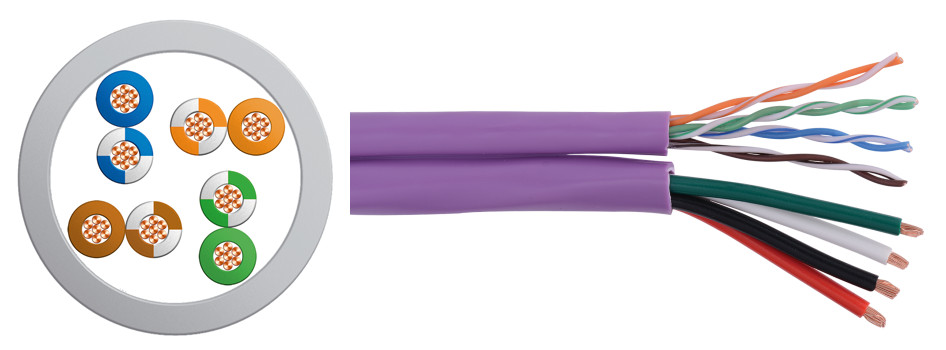Solid vs. Stranded Ethernet Cable: Which to Choose?
Ethernet cable is one of the most important connectivity devices used to connect PCs, switches, and routers to transmit and receive data. To build a reliable connection, it’s important to select suitable cables for specific applications. When choosing between solid vs. stranded ethernet cable, many people are confused. This article aims to explain these two kinds of ethernet patch cables in detail and provide guidance on choosing between solid conductor and stranded conductor cables.
Solid Ethernet Cable
Solid ethernet cables are made up of a single solid wire. Solid conductors usually consist of bare copper wires with diameters between 22 and 24 AWG (American Wire Gauge units). It is worth noting that for solid ethernet cable, the gauge of the solid conductor is the specification for the cable. For example, the diameter of the UTP (Unshielded Twisted Pair) Cat5e patch cable is 24AWG. Featuring large wire diameters, solid wire cables have a lower DC resistance and lower susceptibility to high-frequency effects, so they can provide superior electrical characteristics to keep stable over a wide range of frequencies. But the larger the core, the less inflexible the cable.

Stranded Ethernet Cable
Stranded ethernet cables feature a different cable structure. Inside the twisted pairs of stranded conductor cables, each conductor is made up of a bundle of smaller-gauge stranded wire. Generally, six or seven strands are used to surround a single wire in the center. The outer strands are wrapped helically around the central wires. The stranded wires form a conductor with a similar diameter to a solid cable. However, the conducting area is smaller than that of a solid ethernet cable due to the smaller diameters of each conducting wire strand.
The stranding structure makes stranded ethernet cables flexible. Even though the cables are bent, cables can’t be easily harmed since each strand is independent of the entire strand. And tin-coated conductors can protect the conducting surfaces from oxidation and keep individual wire strands from fraying.

Solid vs. Stranded Ethernet Cable: The Key Differences
Knowing what the two cables are, then what are the differences for the solid vs. stranded ethernet cable? The differences mainly lie in the following six aspects.
The Flexibility
Defined by the cable structure, Stranded conductor cables are more flexible and can sustain more vibration and flex without breaking, while solid ethernet cables are more rigid and can break if flexed too far or too frequently. However, stranded conductor cables can break or become loose over time, while the solid can hold their shape over time and seat properly within insulation displacement connectors (IDCs) on jacks, patch panels, and connecting blocks.
Current Capacity
Solid ethernet cable is thicker, which means less surface area for dissipation. The thinner wires in stranded ethernet cables contain air gaps and greater surface area with the individual strands, translating to more dissipation. When choosing between solid or stranded wire for house wiring, the solid wire cable offers higher current capacity.
Transmission Distance
Solid conductor cables are the better choice for use in scenes requiring long-distance transmission because they feature less current dissipation. With higher insertion loss caused by higher insertion loss and high DC resistance that causes signal dissipation, stranded conductor cable will perform well over shorter distances. So the transmission distance of a solid ethernet cable is usually farther than the stranded one.
The Durability
Solid ethernet cable is very resistant to damage and extremely simple to make. As single, thick strands of cable, they are quite resistant to threats and very easy to produce. Solid wires also have a much more compact diameter compared to stranded cables.
The Cost
Another difference between the two cables is the cost. The production costs of solid ethernet cables are much lower than stranded wire, which makes solid wire the more affordable choice. Stranded wire cables are more expensive than solid ethernet cables for the equivalent length since they are expensive to manufacture.
The Application
These characteristics of the two wire cables determine their different application scenarios. Due to superior electrical performance and stable high frequency, solid ethernet cables are always applied in high-speed ethernet applications like backbone and horizontal cable runs. The cables can support longer distance transmission, making it possible to install in the walls, up through ceilings, or between work areas on the same floor. But attention should be paid to that solid cables shouldn’t be bent, flexed, or twisted repeatedly as they are not very flexible.
Stranded ethernet cables are used for short runs between network interface cards and wallplates or between concentrators and patch panels, hubs, and other rack-mounted equipment, as they will be constantly plugged, removed, or bent. Stranded conductor cable is much more flexible than solid conductor cable. However, it has high attenuation. When you use stranded category cables, remember to restrict their length to reduce insertion loss.
Inclusion
From the above content, solid vs. stranded ethernet cable has been clarified in detail from what solid and stranded conductor cables are, their key differences, and their application scenarios. Knowing all those, please make your wise decision according to your specific network needs.
You might be interested in
Email Address

-
PoE vs PoE+ vs PoE++ Switch: How to Choose?
Mar 16, 2023














